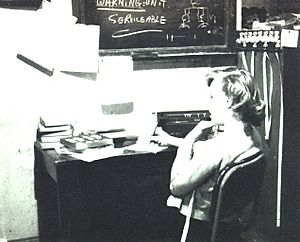Charlotte Froese Fischer facts for kids
Quick facts for kids
Charlotte Froese Fischer
|
|
|---|---|
 |
|
| Alma mater | University of British Columbia University of Cambridge |
| Awards | Sloan Research Fellowship Fellow of the American Physical Society Member, Royal Physiographic Society in Lund Fulbright Senior Research Award Foreign Member, Lithuanian Academy of Sciences Honorary Doctorate, Malmö University Fellow of the Royal Society of Canada Honorary Doctorate, Western University |
| Scientific career | |
| Institutions | University of British Columbia Harvard College Observatory Vanderbilt University National Institute of Standards and Technology |
| Doctoral advisor | Douglas Hartree |
Charlotte Froese Fischer is a famous Canadian-American scientist. She is an applied mathematician, computer scientist, and physicist. She is well-known for creating a special way to study atoms. This method is called the Multi-Configurational Hartree–Fock (MCHF) approach. It helps scientists understand how atoms are built and how they behave.
One of her big achievements was predicting that a negative ion of calcium could exist. This was a new idea because calcium is usually a positive ion. Her prediction led to scientists finding this new type of calcium ion. It was the first time a negative ion of a Group 2 element was discovered. This important discovery helped her become a Fellow of the American Physical Society.
Contents
Early Life and Moving to Canada
Charlotte Froese was born on September 21, 1929. She was born in a village in the Donetsk region of what is now Ukraine. Her parents were from a group called Mennonites. In 1929, her family left Ukraine on the very last train allowed to cross the border. The Soviet authorities then closed the border.
After living in a refugee camp for a few months, her family was allowed to move to Canada. They eventually settled in Chilliwack, British Columbia.
Her Amazing Education
Charlotte Froese studied a lot! She earned two degrees from the University of British Columbia. In 1952, she got a Bachelor's degree in Math and Chemistry. In 1954, she got a Master's degree in Applied Mathematics.
Then, she went to Cambridge University in 1957. There, she earned her Ph.D. in Applied Mathematics and Computing. She even took classes on quantum theory from a famous scientist named Paul Dirac. She worked with Douglas Hartree, helping him program an early computer called EDSAC. This computer was used for calculations about atoms.
Teaching and Research Work
From 1957 to 1968, Charlotte Froese Fischer taught math at the University of British Columbia. She started new courses about computers and how to use numbers to solve problems. She also played a key role in starting the Computer Science Department there.
In 1963-1964, she worked at the Harvard College Observatory. She continued her research on how to calculate the structure of atoms. While at Harvard, she became the first woman scientist to receive an Alfred P. Sloan Fellowship. This is a special award for promising young researchers.
She received many honors for her work. In 1991, she became a Fellow of the American Physical Society. This was partly because of her help in discovering the negative calcium ion. She also became a member of the Royal Physiographic Society in Lund in 1995. In 2004, she joined the Lithuanian Academy of Sciences as a foreign member. Later, in 2015, she received an honorary doctorate from Malmö University in Sweden.
Important Contributions to Science
Charlotte Froese Fischer has written over 300 research papers. These papers are about using computers to understand atoms. Her work has greatly influenced how scientists study atomic structures. An early version of her MCHF computer program received two special awards in 1987.
She also wrote an important book about her method for calculating atomic structure. Later, she co-wrote an even bigger book on the same topic. One of her biggest projects was calculating the full lower spectra for many different ions. This work filled 400 journal pages and covered more than 150 ions!
She also wrote a scientific book about her Ph.D. advisor, Douglas Hartree.
Today, Charlotte Froese Fischer is a retired research professor of computer science at Vanderbilt University. She is also a Guest Scientist at NIST, working with the Atomic Spectroscopy Group. Her husband, Patrick C. Fischer, was also a well-known computer scientist.
See also
 In Spanish: Charlotte Froese Fischer para niños
In Spanish: Charlotte Froese Fischer para niños

